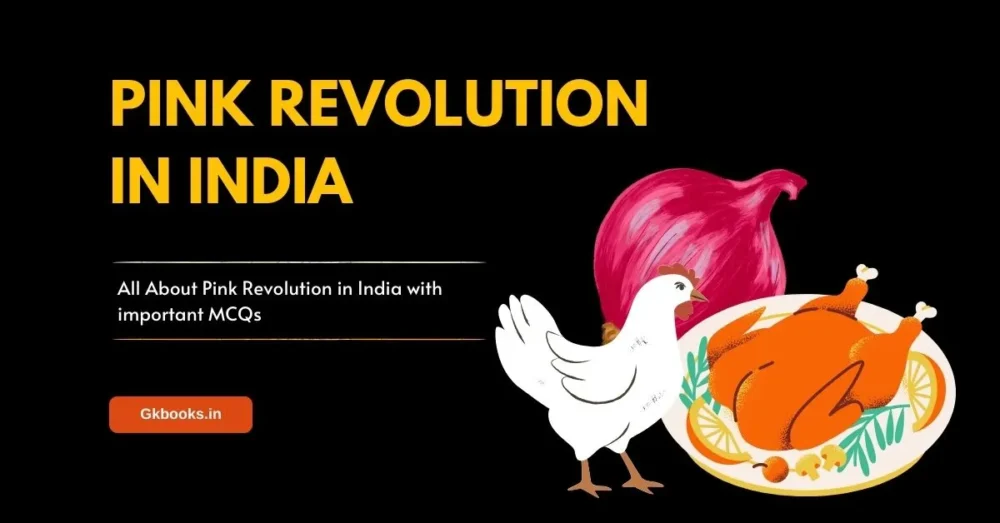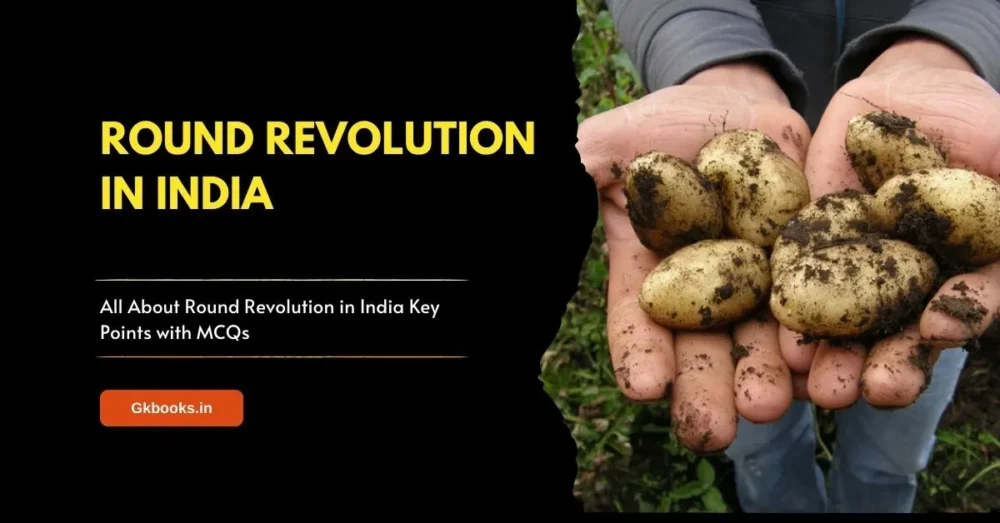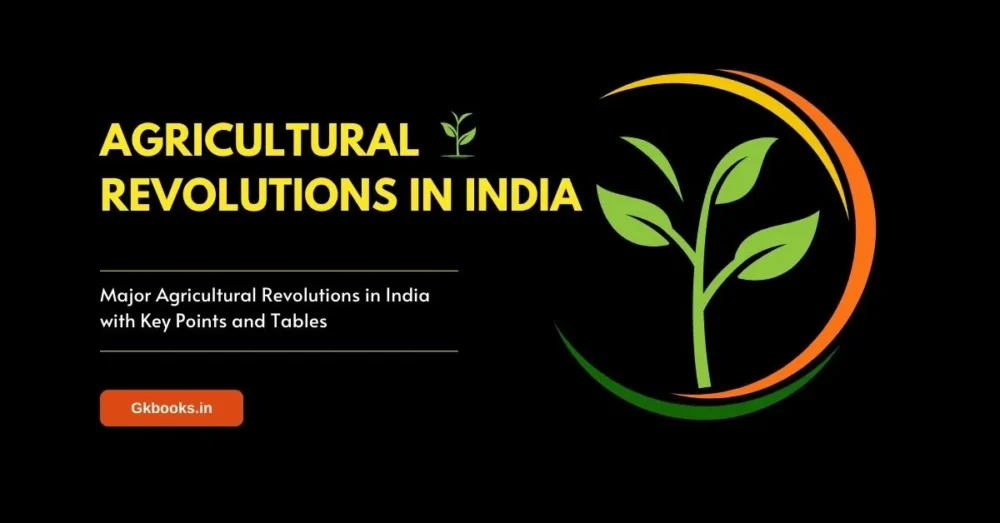Explore the Comprehensive Insights into the Agricultural Grey Revolution in India and enhance your knowledge by attempting the Multiple Choice Questions (MCQs) provided at the end of this article to reinforce your understanding of the Grey Revolution.
The Grey Revolution in agriculture aimed to speed up growth by using fertilizers, and it gained momentum after India successfully introduced seeds that produced more crops. It addressed problems that came up after the Green Revolution and played a vital role. Besides helping crops grow better, it also increased wool production, which boosted agriculture profits.
Can You Answer👇
✅ Question: What initiative did the Ministry of Chemicals and Fertilizer mandate in August 2023 regarding fertilizer bags?
A. Use of organic products
B. Promotion of nano urea
C. Introduction of the ‘Bharat’ brand name
D. Implementation of the IFFCO Nano Urea Spraying Scheme
Answer –C. Introduction of the ‘Bharat’ brand name
Explanation-
Challenge yourself! Engage in extra MCQ practice, which is accessible after the conclusion of this topic.
Also Read: Major Agricultural Revolutions in India from 1960-2024 with MCQs
What is Grey Revolution?
- The inception of the “grey revolution” took place in the aftermath of the 1960s, spurred by the challenges faced during the green revolution.
- Positioning itself as an improved iteration of the Green Revolution, the Grey Revolution aimed to rectify its shortcomings.
- Agritech startup Grey Revolution is at the forefront of developing sustainable solutions for the food system.
- The platform empowers smallholder farmers to enhance yield and profitability to address global food needs.
- This innovative solution allows farmers to concentrate on their core expertise: cultivating food.
- By furnishing tools that support farmers, we can establish a food system that relies less on costly inputs and is more sustainable for agriculture workers.
- In India, the focus shifted to utilizing fertilizers to stimulate growth, following successful years of enhancing seed productivity.
Father of Grey Revolution
In the years following the 1960s, M.S. Swaminathan emerged as the visionary behind India’s Grey Revolution, often dubbed Green Revolution 2.0.
This agricultural movement, spearheaded by Swaminathan, was specifically designed to rectify the shortcomings observed in the preceding Green Revolution.
Focus on Fertilizer Production
Green Revolution 2.0, under the leadership of M.S. Swaminathan, set its sights on boosting fertilizer production to enhance land productivity. The objective was to address certain drawbacks surfaced during the initial Green Revolution.
Rectifying Green Revolution’s Faults
One of the primary roles of the Grey Revolution was to rectify the faults inherent in the Green Revolution. By doing so, it aimed to optimize agricultural practices and outcomes.
Bridging the Yield Gap
A notable achievement of the Grey Revolution has been its success in bridging the gap between theoretical yields observed in scientific studies and the practical yields witnessed in the real world. This synchronization has significantly accelerated productivity and growth in the agricultural sector.
Challenges in Agricultural Promotion
Despite its successes, promoting and encouraging agriculture remained a formidable challenge for the Grey Revolution. Striking a balance between production needs and environmental sustainability posed ongoing challenges.
Predicting Future Food Demands
Anticipating and aligning with future demands for food proved to be another complex challenge. The evolving nature of food requirements and the capacity of existing food networks made predictions and adjustments a constant challenge for the architects of the Grey Revolution.
Objectives of the Grey Revolution
The Grey Revolution aimed to rectify key drawbacks of the Green Revolution, including:
- The decline in Punjab’s Rice Production Growth Rate: One major drawback was the substantial drop in Punjab’s rice production growth rate, plummeting from 9% between 1965 and 1974 to 1.13% in 1995-96.
- Reduction in Pulses Cultivation: The area dedicated to pulses experienced a considerable reduction.
- Resource-Intensive Rice Farming: Summer rice farming demanded excessive energy and water resources.
- Increased Challenges with Diseases, Pests, and Weeds: Diseases, pests, and weeds became more prevalent, causing a significant decline in biodiversity.
- Higher Concentrations of Aero-Solution in Urban Areas: Urban areas now face elevated concentrations of aero-solution.
- Overuse of Groundwater: Groundwater overuse escalated, leading to increased water pumping costs and reduced profitability.
- Impact on Sanitation and Related Conditions: A decline in sanitation and related conditions emerged as a significant contributor to the challenges posed by the green revolution.
Strategies of the Grey Revolution
The grey revolution employs the following strategies to overcome the previous limitations, and it’s important to note that these techniques are actively being implemented:
- Diversification of Agricultural Productions: Prioritizing the cultivation of pulses, oilseeds, horticulture, aquaculture, and cattle to enhance agricultural diversity.
- Enhanced Productivity and Growth: This revolution boosts productivity, closes yield gaps, and promotes overall growth.
- Adoption of Climate Smart Agriculture: Implementing practices that align with climate-smart agriculture to enhance resilience to changing environmental conditions.
- Utilization of Biotechnology and Genetic Engineering: Incorporating biotechnology and genetic engineering to drive innovation in agricultural practices.
- Integrated Biosecurity Approach: Addressing risk factors for food safety through the implementation of an integrated biosecurity approach.
- UNICEF’s Social Policy and Protection Initiatives in India: UNICEF’s efforts in India, particularly in social policy and protection, contribute to the advancement of children’s rights.
- National Food Security Act of 2013: The enactment of the National Food Security Act of 2013, also known as the Right to Food Act, aimed at providing subsidized food grains to around two-thirds of India’s 1.2 billion people.
- Farmer Field School Method: Educating farmers to enhance their knowledge and skills through the farmer field school method.
- Facilitating Access to Modern Technologies: Advocating for the agricultural industry to provide farmers access to contemporary technologies and professional management.
- Implementation of Impact Evaluation in Agriculture: Incorporating impact evaluation, including impact assessment and monitoring, to gauge the effectiveness of interventions in the agricultural sector.
Challenges of the Grey Revolution
Despite the implementation of strategies, significant challenges persist in meeting the demands and expectations of farmers in India. These challenges include:
- Sustainable Output Increase: The primary challenge is to sustainably increase agricultural output to meet global demands for both quantity and quality of food.
- Professionalization of Agriculture: Adopting a professional approach to agriculture is essential to enhance profitability and the overall appeal of the agricultural sector.
- Preserving Ecosystem Services: Balancing the need for increased output with maintaining ecosystem services, such as soil health, biodiversity, carbon sequestration, and wildlife habitat, proves to be a challenging task.
- Anticipating Future Agricultural Demands: It is challenging to anticipate and address the evolving differences in future food, agricultural, and demand requirements. Meeting these changing dynamics poses a continuous challenge in the realm of agriculture.
Fertilizer Industry of India Key Facts
- The Indian fertilizer market is projected to grow at a CAGR of 4.7% between 2024 and 2032, reaching a value of USD 1394.16 billion by 2032.
- Market growth is attributed to the increasing demand for food production and advancements in agriculture processes.
- In September 2023, Coromandel International launched an organic product named Cumist Calcium, containing specialty nutrients to enhance efficiency and soil health.
- The Ministry of Chemicals and Fertilizer mandated companies to use the new brand name ‘Bharat’ and the subsidy scheme logo on fertilizer bags in August 2023.
- The Gujarat Chief Minister introduced the IFFCO Nano Urea Spraying Scheme in August 2023, promoting the use of drone technology in agriculture to spray nano urea.
- Coromandel International previously launched GroShakti Fertilizer in September 2021, featuring advanced technology and high nutrient percentage with less filler material.
- Key drivers for market growth include the rising demand for food, increasing consumer base, and expansion of fertilizer companies into seeds and fungicides.
- The India fertilizer market is segmented by type (chemical fertilizer and biofertilizer), product (nitrogenous, phosphatic, potash, and complex fertilizers), formulation (liquid and dry), and application (grains, pulses, commercial crops, fruits, and vegetables).
- Major regions for fertilizer markets in India are North, West, South, and East & Central India.
- Key players in the market include Coromandel International Limited, Chambal Fertilisers and Chemicals Ltd, IFFCO, and others.
- The liquid segment is expected to gain momentum, and nitrogenous fertilizers, particularly urea, are anticipated to grow in the market.
- Notable companies like Coromandel International, Chambal Fertilisers, and Rama Phosphates contribute significantly to the competitive landscape of the Indian fertilizer market.
Conclusion
In the aftermath of the 1960s, the “grey revolution” emerged, driven by a commitment to rectify the shortcomings of the “green revolution.” A key focus of this revolution was augmenting land productivity through an increase in fertilizer output. Recognizing the imperfections of the green revolution, the grey revolution stepped in to address these issues. This revolution has significantly accelerated production and growth by closing the disparity between scientific research yields and real-world observations.
Grey Revolution in India: FAQs
The grey revolution in India refers to the increased production and use of chemical fertilizers in agriculture, primarily during the 1960s and 1970s. It aimed to boost crop yields and address food security concerns, but it also raised concerns about the negative environmental consequences of excessive fertilizer use.
While there’s no single individual credited with initiating the grey revolution, scientists like Dr. M.S. Swaminathan were involved in promoting fertilizer use during the Green Revolution, which inadvertently led to the “grey” aspects. Additionally, government policies and agricultural companies played a significant role in expanding fertilizer production and usage.
The grey revolution is primarily associated with agriculture, specifically with the intensive use of chemical fertilizers to enhance crop yields. However, its impact extends beyond agriculture, affecting soil health, water quality, and environmental sustainability.
Although there’s no precise starting point, the increased focus on fertilizer production and use gained momentum in the 1960s as part of the Green Revolution initiatives in India.
Sample MCQs to Boost Your Understanding on Grey Revolution
Q1. What is the Grey Revolution?
A. An uprising against the Green Revolution
B. An improved iteration of the Green Revolution
C. A political movement in agriculture
D. A revolution in the fashion industry
Answer –B. An improved iteration of the Green Revolution
Explanation-
Q2. When did the inception of the Grey Revolution take place?
A. 1950s
B. 1960s
C. 1970s
D. 1980s
Answer –B. 1960s
Explanation-
Q3. What challenges led to the development of the Grey Revolution?
A. Technological advancements
B. Successes of the Green Revolution
C. Environmental concerns
D. Economic stability
Answer –C. Environmental concerns
Explanation-
Q4. Which country has an agritech startup named Grey Revolution?
A. United States
B. China
C. India
D. Brazil
Answer –C. India
Explanation-
Q5. What is the primary focus of Grey Revolution’s sustainable solutions?
A. Industrial manufacturing
B. Smallholder farmers’ empowerment
C. Information technology
D. Renewable energy sources
Answer –B. Smallholder farmers’ empowerment
Explanation-
Q6. What was the primary method used in the Grey Revolution to speed up agricultural growth?
A. Genetic modification
B. Irrigation techniques
C. Use of fertilizers
D. Crop rotation
Answer –C. Use of fertilizers
Explanation-
Q7. What contributed to the momentum of the Grey Revolution in India?
A. Introduction of technology
B. Successful introduction of high-yielding seeds
C. Adoption of organic farming practices
D. Implementation of advanced irrigation systems
Answer –B. Successful introduction of high-yielding seeds
Explanation-
Also Read: All About Round Revolution in India Key Points with MCQs
Q8. Besides enhancing crop growth, what other aspect did the Grey Revolution impact, leading to increased profits in agriculture?
A. Livestock management
B. Wool production
C. Aquaculture
D. Horticulture
Answer –B. Wool production
Explanation-
Q9. What role did the Grey Revolution play in agriculture?
A. Increased reliance on traditional farming methods
B. Introduction of genetically modified organisms
C. Addressed challenges from the Green Revolution and enhanced agricultural practices
D. Promoted monoculture for higher yields
Answer –C. Addressed challenges from the Green Revolution and enhanced agricultural practices
Explanation-
Q10. Who is often referred to as the Father of the Grey Revolution in India?
A. M.S. Swaminathan
B. Norman Borlaug
C. Vandana Shiva
D. C. Subramaniam
Answer –A. M.S. Swaminathan
Explanation-
Q12. What is the Grey Revolution sometimes dubbed as?
A. Green Revolution 2.0
B. Agriculture Revolution Redux
C. Sustainable Farming Movement
D. Agrarian Renaissance
Answer –A. Green Revolution 2.0
Explanation-
Q13. What was the specific focus of the Grey Revolution led by M.S. Swaminathan?
A. Livestock management
B. Irrigation techniques
C. Boosting fertilizer production
D. Crop rotation practices
Answer –C. Boosting fertilizer production
Explanation-
Q14. What was one of the primary objectives of the Grey Revolution concerning agricultural practices?
A. Promoting monoculture
B. Addressing drawbacks of the Green Revolution
C. Implementing advanced irrigation systems
D. Focusing on organic farming practices
Answer –B. Addressing drawbacks of the Green Revolution
Explanation-
Q15. What complex challenge did the architects of the Grey Revolution face in predicting future food demands?
A. Lack of technological advancements
B. Insufficient funding
C. Balancing production needs and environmental sustainability
D. Inadequate knowledge about agricultural practices
Answer –C. Balancing production needs and environmental sustainability
Explanation-
Q16. In September 2023, which company launched an organic product named Cumist Calcium?
A. IFFCO
B. Chambal Fertilisers and Chemicals Ltd
C. Coromandel International Limited
D. Ministry of Chemicals and Fertilizer
Answer –C. Coromandel International Limited
Explanation-
Q17. What specialty nutrients are present in the organic product Cumist Calcium launched by Coromandel International?
A. Nitrogenous and phosphatic
B. Nano urea
C. Advanced technology
D. Fungicides
Answer –A. Nitrogenous and phosphatic
Explanation-
Q18. In August 2023, which Indian state’s Chief Minister introduced the IFFCO Nano Urea Spraying Scheme?
A. Maharashtra
B. Gujarat
C. Uttar Pradesh
D. Tamil Nadu
Answer –B. Gujarat
Explanation-
Q19. Which product did Coromandel International launch in September 2021 featuring advanced technology and a high nutrient percentage?
A. Cumist Calcium
B. GroShakti Fertilizer
C. IFFCO Nano Urea
D. Bharat Fertilizer
Answer –B. GroShakti Fertilizer
Explanation-
Sources:
Discover More: Recommended Reads




